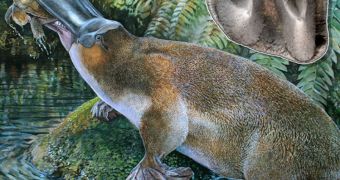According to the conclusions of a new scientific study, Australia was home to a species of giant platypus between 5 and 15 million years ago. The only evidence to support this claim is a single tooth the investigators found, which provided the basis for an effort to reconstruct the entire mammal.
It is possible that the ancient duck-billed platypus reached a length of 1 meter (3.3 feet), making it twice as large as its modern-day descendants. Based on a careful analysis of the tooth, researchers concluded that the animal most likely feasted on frogs, fish, and perhaps even turtles.
In the study, published in the latest issue of the esteemed Journal of Vertebrate Paleontology, the researchers highlight that previous work never hinted at the possibility of platypuses developing extreme bodies. They say that the entire evolutionary tree for the species may need to be revised.
Even “conventional” platypuses are very strange. They are mammals, but yet they reproduce by laying eggs like reptiles. They have duck bills and webbed feet – making them adept swimmers – but are also the only venomous mammals in the world, and the only species to feature 10 gender chromosomes.
Some experts believe that the creatures' genomes are not yet “finished,” in the sense that they generously display both mammal and reptilian traits. Together with four species of echidna, the modern duck-billed platypus (Ornithorhynchus anatinus) is the only survivor of a group of mammals called Monotremes.
“A new platypus species, even one that is highly incomplete, is a very important aid in developing understanding about these fascinating mammals,” explains the lead author of the new paper, PhD candidate Rebecca Pian, from the University of New South Wales (UNSW).
The ancient species of giant platypuses, now called Obdurodon tharalkooschild, proved to be even weirder than its living relative, through the fact that it had teeth. Currently, these mammals are born with teeth, but lose them during the first few days of life, Mongabay reports.
“Like other platypuses, [Obdurodon tharalkooschild] was probably a mostly aquatic mammal, and would have lived in and around the freshwater pools in the forests that covered the Riversleigh area millions of years ago,” concludes UNSW expert Suzanne Hand, also a coauthor of the study.

 14 DAY TRIAL //
14 DAY TRIAL //